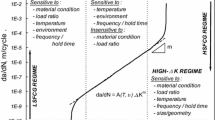Abstract
A micromechanistic model of warm pre-stressing is extended to predict the combined effects of warm pre-stressing and strain ageing on the cleavage fracture toughness of ferritic steels. The crack tip stress distribution after a cycle of pre-straining and strain ageing is estimated by superposition of the appropriate monotonic loading stress distributions. The Ritchie, Knott and Rice model of cleavage fracture and its associated fracture criterion are employed in conjunction with the crack tip stress distribution to predict the critical stress intensity factor after warm pre-stressing and strain ageing.
Illustrative calculations are presented, based upon the published material's properties of a high nitrogen mild steel. Available experimental data for pressure vessel steels bear out the form of the predictions. At low temperatures, and after heavy pre-loads, the benefits of warm pre-stressing dominate strain ageing induced embrittlement and the toughness is apparently enhanced. At higher temperatures, or after small pre-loads, however, strain ageing dominates and the apparent toughness is reduced.
Various assumptions and approximations inherent in the model are discussed. These generally tend to render the predictions conservative. Finally it is noted that the model should be equally applicable to the prediction of the combined effect of warm pre-stressing and neutron irradiation on the cleavage fracture toughness of ferritic steels.
Résumé
Un modèle micromécanique de la précontrainte à chaud a été étendu en vue de prédire les effets combinés de précontrainte à chaud et de vieillissement sur la ténacité à la rupture par clivage des aciers ferritiques. La distribution de contraintes à l'extrémité d'une fissure après un cycle de précontrainte et de vieillissement a été estimée en superposant les distributions correspondantes de contrainte monotone. Le modèle de Ritchie, Knott et Rice pour la rupture par clivage et le critère de rupture qui y est associé ont été employés en combinaison avec la distribution des contraintes à l'extrémité de la fissure en vue de prédire le facteur critique d'intensité de contrainte après précontrainte à chaud et vieillissement.
On présente, à titre illustratif, des calculs basés sur les propriétés des matériaux publiés dans le cas d'un acier doux à haute teneur en azote. Les données expérimentales disponibles pour les aciers pour récipients sous pression supportent les prédictions formulées. A basse température et avec des précharges sévères, le bénéfice de la précontrainte à chaud l'emporte sur la fragilisation dû au vieillissement, et la ténacité est apparemment relevée. A plus haute température ou après contrainte moins sévère cependant, c'est le vieillissement qui domine et la ténacité apparente est réduite.
Diverses hypothèses et approximations inhérentes au modèle sont discutées. Elles tendent généralement à rendre les prédictions conservatives. Finalement, on note que le modèle devrait être également applicable à la prédiction d'effets combinés de préchauffe à chaud et d'irradiation neutronique sur la ténacité à la rupture par clivage des aciers ferritiques.
Similar content being viewed by others
References
J.D. Baird,Metallurgical Reviews 16 (1971) 1.
A.H. Cottrell and B.L. Bilby,Proceedings of the Physical Society, (A) 62 (1949) 49.
C.L. Formby and W. Charnock,Proceedings of the Conference on the Practical Application of Fracture Mechanics to Pressure Vessel Technology, Paper 1, Institute of Mechanical Engineers, London (1971).
L.N. Succop, A.W. Pense and R.D. Stout,Welding Journal 51 (1970) Research Supplement 354–364S.
D.A. Curry,International Journal of Fracture 17 (1981) 335–343.
R.O. Ritchie, J.F. Knott and J.R. Rice,Journal of Mechanics and Physics of Solids 21 (1973) 395–410.
G.G. Chell, J.R. Haigh and V. Vitek,International Journal of Fracture 17 (1981) 61–81.
J.R. Rice, inFatigue Crack Propagation, ASTM Special Technical Publication 415, ASTM, Philadelphia (1967) 247–309.
D.A. Curry,Materials Science and Engineering 43 (1980) 135–144.
D.M. Tracey, Transactions of the American Society of Mechanical Engineers,Journal of Engineering Materials and Technology 98 (1976) 146–151.
W.J. Ostergren, Master's Thesis, Brown University, Rhode Island, U.S.A. (1969).
I. Milne and D.A. Curry inFracture and Fatigue: Elastoplasticity, Thin Sheet and Micromechanisms Problems, Proceedings of the 3rd European Colloquium on Fracture, ed. J.C. Radon, Pergamon, Oxford (1980) 39–47.
A.I. Rubin, J.H. Gross and R.D. Stout,Welding Journal 38 (1959) Research Supplement 182S.
T.C. Harrison and G.D. Fearnehough,Metal Construction and the British Welding Journal 1 (1969) 476–478.
D.A. Curry,Metal Science 14 (1980) 78–80.
J.D.G. Groom and J.F. Knott,Metal Science 9 (1975) 390–400.
B.A. Bilby,Proceedings ofthe 3rd International Conference on Fracture, Ed. A. Kochendörfer, Vol. XI, Paper 1111, Verein Deutsche Eisenhüttenleute, Düsseldorf (1973).
J.R. Rice, ibid, Vol. II, Paper 1–441.
J.R. Rice and E.P. Sorensen,Journal of the Mechanics and Physics of Solids 26 (1978) 163–186.
S.J. Garwood, Ph.D. Thesis, Imperial College, London (1977).
D.M. Parks, Transactions of the American Society of Mechanical Engineers,Journal of Engineering Materials and Technology 98 (1976) 30–35.
Author information
Authors and Affiliations
Rights and permissions
About this article
Cite this article
Curry, D.A. A model for predicting the influence of warm pre-stressing and strain ageing on the cleavage fracture toughness of ferritic steels. Int J Fract 22, 145–159 (1983). https://doi.org/10.1007/BF00942720
Received:
Issue Date:
DOI: https://doi.org/10.1007/BF00942720




